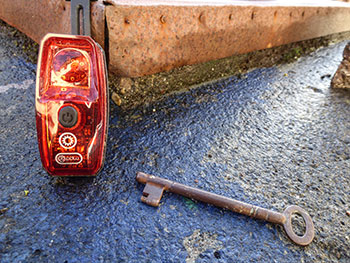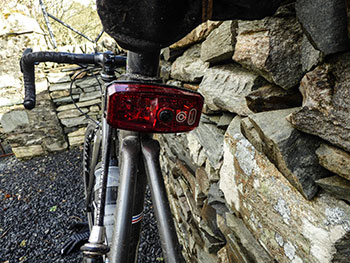
..........................................................................................................................................................................................................
portland design works daybot tail light

at the consumer electronics show held in las vegas at the beginning of january this year, trek bicycles and ford america announced a collaborative effort to enable communication between bike and car. their definition of communication does not, however, encapsulate a means of affording cyclists the opportunity to shout at errant drivers, or, indeed, vice versa, but adoption of cellular vehicle-to-everything technology. this may well be an astute move on behalf of trek, as vehicular design edges ever closer to the so-called autonomous vehicle or as we more colloquially refer, the driverless car.

a quick poll around the office evinced little confidence in the above, even though there are many contemporary vehicles already incorporating the fringes of this technology, demonstrating the ability to park in small spaces that would often challenge those who consider themselves to be particularly decent drivers. however, if and when driverless cars take to the roads, the promised advantages of excluding the person behind the steering wheel relies greatly on cars, talking to cars, talking to cars. this talking essentially means making each vehicle into a single node on an extended network, thus making car travel into what might legitimately be described as an extra-sensory digital experience.
the concern that, from the cyclists' point of view at least, were bicycles to remain outside this cellular vehicle-to-everything technology, means essentially that bicycles would remain electronic persona non grata, possibly excluded from any spatial interrogations made by the surrounding motor vehicles. ultimately, for the technology to work as efficiently as possible, the world's pedestrian population will no doubt have need of an app on their smartphones, broadcasting their every move to both bicycles and motor vehicles. what price orwell's 1984 when that arrives?

meantime, back in the real world, the average commuting cyclist has still to keep their wits about them when entering the miasma that constitues rush-hour traffic. for at present, we still rely on good old human senses and all the failings present therein. but, as many are already aware, there are plenty of available assistants to help advertise velocipedinal presence midst the motoring circus. and as if to add insult to injury, fiat are currently advertising a range of vehicles incorporating the ability to display favoured smartphone apps on a central screen. this seems something of an anomaly considering the legislation forbidding drivers from using their phones while driving. shifting the focus to a dashboard screen hardly seems to ameliorate that strand of the law.
in the face of what appears to be sanctioned adversity, and not just after dark, it's no longer simply a case of hoping to be seen, but more one of jumping about and waving our existence. and one of the best ways to start would be to fit a portland design works daybot tail light. making use of car technology in the shape of a light emitting diode straight from car brake lights, the daybot light has the ability to shine every bit as bright as your favourite or less than favourite motor vehicle. pdw have perceptively paid heed to the fact that the modern-day cyclist no longer makes use of a rear light solely after dark.

the daybot features a 100 lumen daytime pulse mode (as well as a 60 lumen static mode), because even on those days when daylight is in plentiful supply, the skies can be overcast and thus lowering our visibility. you know, the days when silver coloured cars become all but invisible. and should your conscience prevent you from glaring too brightly rearwards at following vehicles, the daybot is easily switchable to one of three less frightening night modes, a change which also conserves the unit's battery life.
the latter, even when switched to static mode, is most impressive. i achieved well over forty-eight continuous hours before recharging was necessary, easily accomplished via the ubiquitous usb cable. the included rubber bungee allows the light to be attached to pretty much any diameter of seatpost either vertically or horizontally, without any change to its effectiveness. should that be a less than favourable option, there's also a seatstay bracket included as an alternative.
unlike several other tail lights on the market, switching the light on and off is easily achieved by means of a large(ish) rubber button in the centre of the light. this is far easier to access than the more often found hard switch on the base or rear. until technology affords seamless communication between all those using the public roads, pdw's daybot tail light is a more than convenient means of avoiding the smidsy acronym (sorry mate, i didn't see you) even in the hours of daylight.
the portland design works daybot tail light retails at $35 (approximately £25).
portland design works daybot tail light
saturday 17 february 2018
 ..........................................................................................................................................................................................................
..........................................................................................................................................................................................................